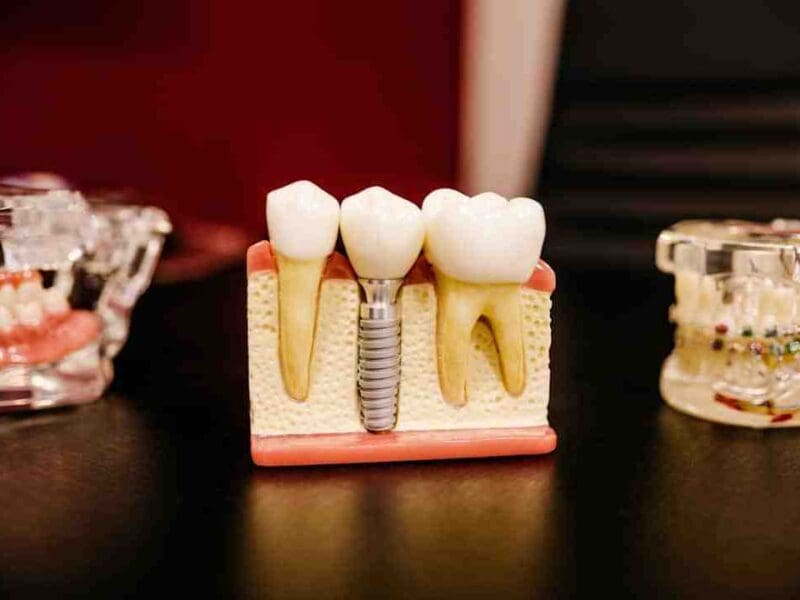
Gum Disease Treatment
Gum disease or periodontitis, is a prevalent oral health condition affecting the tissues surrounding and supporting the teeth. It is a chronic bacterial infection that gradually damages the gums, ligaments, and bone structure, holding the teeth in place.
This oral condition often begins with inflammation and swelling of the gums, known as gingivitis, which, if left untreated, can progress to a more severe form called periodontitis. This common yet serious condition can have far-reaching consequences beyond oral health, potentially impacting a person’s overall well-being.
One of the primary causes of gum disease is the accumulation of a sticky film that forms on the teeth, called plaque. When you neglect to brush your teeth regularly, this hardens into what people call tartar or calculus, providing a conducive environment for bacterial growth.
The bacteria release toxins that irritate the gums, leading to inflammation and redness. This initial stage, gingivitis, is characterized by bleeding gums, bad breath, and gum sensitivity. However, if left untreated, the infection can progress, causing the gums to recede, teeth to become loose, and even bone loss in severe cases.
So, what is the best gum disease treatment?
How to Treat Gum Disease
1. Professional Dental Cleaning
Professional dental cleanings, also known as scaling and root planing, are essential for treating gum disease. During this procedure, a dental professional uses specialized tools to remove the hard substance, known as plaque, from the teeth and along the gum line. This helps eliminate the bacteria responsible for gum disease and prevents further damage to the gums and supporting structures.
2. Antibacterial Mouthwash
An antibacterial mouthwash can be an effective adjunct to regular brushing and flossing. It helps reduce the bacteria in the mouth, promoting gum health. Look for mouthwashes that contain ingredients like chlorhexidine, which have been shown to combat gum disease-causing bacteria effectively.
3. Dental Antibiotics
In some cases of advanced gum disease, your dentist may prescribe antibiotics to control the bacterial infection. Antibiotics can help eliminate or reduce the number of bacteria causing gum disease, allowing the gums to heal. They are typically used in conjunction with other gum disease treatments.
4. Improved Oral Hygiene
Maintaining oral hygiene is crucial for treating and preventing gum disease. This includes brushing your teeth at least 2 times daily with a soft toothbrush and toothpaste, preferably with fluoride. You should also floss daily to remove food particles and plaque buildup between the teeth and along the gum line, reducing the risk of gum disease.
5. Dental Scaling and Root Planing
Scaling and root planing involves removing plaque and tartar from the surfaces of the teeth and the roots below the gum line. This process helps smooth the tooth roots, preventing bacteria from reattaching and allowing the gums to reattach to the tooth surfaces. And this deep cleaning procedure is typically performed by a dental professional. It
6. Laser Therapy
Laser therapy is a modern approach to treating gum disease. It involves using a dental laser to target and remove infected gum tissue while promoting healthy tissue regeneration. Laser therapy is a minimally invasive and comfortable treatment option, often resulting in reduced bleeding, swelling, and discomfort compared to traditional gum surgery.
7. Gum Grafting
Gum grafting is a surgical procedure used to treat advanced gum disease and restore receding gum tissue. During the process, the healthy gum tissue is taken from another part of the mouth or a donor source and attached to the affected area. This helps cover exposed tooth roots and protects them from further damage.
8. Dental Implants
Dental implants can be an effective treatment option in cases where gum disease has led to tooth loss. Dental implants are artificial tooth roots surgically placed into the jawbone, providing a stable foundation for replacement teeth. Dental implants can help restore function and improve oral health by replacing missing teeth.
9. Orthodontic Treatment
In some cases, orthodontic treatment may be recommended to address gum disease. Misaligned or crowded teeth can make it challenging to maintain proper oral hygiene, leading to an increased risk of gum disease. By correcting the alignment of the teeth, orthodontic treatment can make it easier to keep the gums clean and healthy.
10. Lifestyle Changes
Certain lifestyle habits can contribute to gum disease or hinder its treatment. Quitting smoking or tobacco use is crucial, as tobacco products can worsen gum disease and impede healing. Adopting a healthy diet rich in fruits, vegetables, and lean proteins while limiting sugary foods and beverages can support gum health and oral well-being.
It’s important to note that the appropriate treatment for gum disease may vary depending on the severity and progression of the condition. Consulting with a South Morang dental professional is vital to determine the most suitable treatment plan.
So, when your gums start to swell, don’t hesitate to set a dental appointment with SmileVille and keep those gums and teeth healthy!







